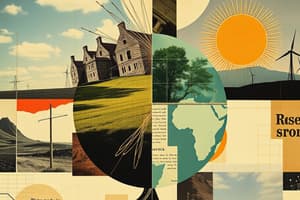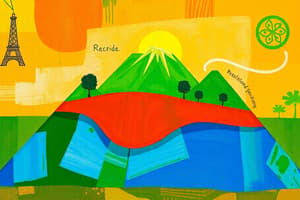Podcast
Questions and Answers
Define renewable resources. Give at least three examples.
Define renewable resources. Give at least three examples.
Renewable resources are natural resources that can replenish themselves over time. Examples include solar energy, wind energy, and hydropower.
Define non-renewable resources. Give at least four examples.
Define non-renewable resources. Give at least four examples.
Non-renewable resources are natural resources that are finite and cannot be replenished at a rate comparable to their consumption. Examples include fossil fuels (coal, oil, natural gas), minerals, and nuclear fuels.
Define inexhaustible resources. Give three examples.
Define inexhaustible resources. Give three examples.
Inexhaustible resources are natural resources that are considered practically unlimited and are not depleted by human use. Examples include solar energy, wind energy, and geothermal energy.
Identify the stage, level of development (MDC, NIC, LDC), dependency ratio (high, low, elderly, young or both). What challenges might this stage face in the present or future? Answer these questions for all four pyramids. Country A:
Identify the stage, level of development (MDC, NIC, LDC), dependency ratio (high, low, elderly, young or both). What challenges might this stage face in the present or future? Answer these questions for all four pyramids. Country A:
Which stages of population pyramids would have a growing population? Which ones would have a declining population?
Which stages of population pyramids would have a growing population? Which ones would have a declining population?
What four things can be inferred in a population pyramid?
What four things can be inferred in a population pyramid?
Define cultural hearth.
Define cultural hearth.
Define cultural diffusion. Give two examples.
Define cultural diffusion. Give two examples.
What are latitude/parallel lines? Which way do they measure?
What are latitude/parallel lines? Which way do they measure?
What are longitude/meridian lines? Which way do they measure?
What are longitude/meridian lines? Which way do they measure?
What is the difference between a political map, a physical map and a thematic map?
What is the difference between a political map, a physical map and a thematic map?
What is a cartogram?
What is a cartogram?
What three physical features typically draw the highest populations?
What three physical features typically draw the highest populations?
What does GPS stand for? What does it do?
What does GPS stand for? What does it do?
How does life differ in rural areas compared to urban areas? (culturally)
How does life differ in rural areas compared to urban areas? (culturally)
Define polytheistic. Which religion is polytheistic?
Define polytheistic. Which religion is polytheistic?
Define monotheistic. Which religions are monotheistic?
Define monotheistic. Which religions are monotheistic?
Define animistic.
Define animistic.
Define enculturation.
Define enculturation.
Identify the religion for each column.
Identify the religion for each column.
Identify the religion and the branch of the religion for each color.
Identify the religion and the branch of the religion for each color.
How does latitude affect climate?
How does latitude affect climate?
Define globalization. Why are some people opposed to globalization?
Define globalization. Why are some people opposed to globalization?
Define subsistence farming. Be able to identify subsistence farming in an example.
Define subsistence farming. Be able to identify subsistence farming in an example.
Define commercial farming.
Define commercial farming.
Define a free market economy. What is a word commonly associated with free market economy? What type of government is it usually associated with?
Define a free market economy. What is a word commonly associated with free market economy? What type of government is it usually associated with?
Define mixed economy. What is a word commonly associated with mixed economy?
Define mixed economy. What is a word commonly associated with mixed economy?
Define command economy. What is a word commonly associated with command economy? What types of government are usually associated with command economy?
Define command economy. What is a word commonly associated with command economy? What types of government are usually associated with command economy?
Define primary economic sector. Give at least three examples.
Define primary economic sector. Give at least three examples.
Define secondary economic sector. Give at least three examples.
Define secondary economic sector. Give at least three examples.
Define quaternary economic sector. Give at least three examples.
Define quaternary economic sector. Give at least three examples.
Define quinary economic sector. Give at least two examples.
Define quinary economic sector. Give at least two examples.
Summarize the history of Israel/Palestine. Be able to identify on a map the Palestinian territories.
Summarize the history of Israel/Palestine. Be able to identify on a map the Palestinian territories.
Identify the name of location A.
Identify the name of location A.
Identify the name of location B. Why is it such an important choke point/strategic waterway in Southwest Asia?
Identify the name of location B. Why is it such an important choke point/strategic waterway in Southwest Asia?
Define Zionism.
Define Zionism.
What statistic would you look at to determine standard of living?
What statistic would you look at to determine standard of living?
What statistics would you use to determine LDC, NIC, MDC?
What statistics would you use to determine LDC, NIC, MDC?
What rate does the total fertility rate have to be to have a growing population?
What rate does the total fertility rate have to be to have a growing population?
Define immigrant.
Define immigrant.
Define refugee.
Define refugee.
Define internally displaced persons.
Define internally displaced persons.
Define pull factors. Give examples.
Define pull factors. Give examples.
Define asylum seekers.
Define asylum seekers.
Define formal region. Give two examples and explain why they are formal regions.
Define formal region. Give two examples and explain why they are formal regions.
Define functional region. Give two examples and explain why they are functional regions.
Define functional region. Give two examples and explain why they are functional regions.
Define perceptual region. Give two examples and explain why they are perceptual regions.
Define perceptual region. Give two examples and explain why they are perceptual regions.
Identify on a map the Sinai, Anatolian and Arabian Peninsulas.
Identify on a map the Sinai, Anatolian and Arabian Peninsulas.
Describe absolute monarchy.
Describe absolute monarchy.
Describe presidential democracy.
Describe presidential democracy.
Describe parliamentary democracy.
Describe parliamentary democracy.
Describe a dictatorship.
Describe a dictatorship.
Describe a theocracy.
Describe a theocracy.
Define absolute and relative locations. Give an example of each.
Define absolute and relative locations. Give an example of each.
When looking at Human Environment Interaction...define modification, adaptation and dependency. Give examples of each.
When looking at Human Environment Interaction...define modification, adaptation and dependency. Give examples of each.
Where are the majority of people located in Egypt and why?
Where are the majority of people located in Egypt and why?
Define Nation. Give examples.
Define Nation. Give examples.
Define state.
Define state.
Define nation state and give examples.
Define nation state and give examples.
Define a stateless nation and give examples.
Define a stateless nation and give examples.
Define commodity dependency. What region of the world needs to diversify their economies the most?
Define commodity dependency. What region of the world needs to diversify their economies the most?
Define brain drain.
Define brain drain.
Define standard of living and quality of life.
Define standard of living and quality of life.
Define Human Development Index. What three things does it measure?
Define Human Development Index. What three things does it measure?
Describe the Cold War.
Describe the Cold War.
Define supranational organization. Give three examples.
Define supranational organization. Give three examples.
What is the relationship between total fertility rates and levels of a country's development?
What is the relationship between total fertility rates and levels of a country's development?
Flashcards
Renewable resources
Renewable resources
Resources that can be replenished over time, such as solar, wind, and hydro power.
Non-renewable resources
Non-renewable resources
Resources that are finite and cannot be replenished at a rate comparable to their consumption. Examples include fossil fuels (coal, oil, natural gas), minerals (iron ore, copper), and nuclear fuels (uranium).
Inexhaustible resources
Inexhaustible resources
Resources that are virtually inexhaustible and are not depleted by human use. Examples include solar energy, wind energy, and geothermal energy.
Cultural hearth
Cultural hearth
Signup and view all the flashcards
Cultural diffusion
Cultural diffusion
Signup and view all the flashcards
Lines of latitude/parallel lines
Lines of latitude/parallel lines
Signup and view all the flashcards
Lines of longitude/meridian lines
Lines of longitude/meridian lines
Signup and view all the flashcards
Political, physical, and thematic maps
Political, physical, and thematic maps
Signup and view all the flashcards
Cartogram
Cartogram
Signup and view all the flashcards
Polytheistic
Polytheistic
Signup and view all the flashcards
Monotheistic
Monotheistic
Signup and view all the flashcards
Animistic
Animistic
Signup and view all the flashcards
Enculturation
Enculturation
Signup and view all the flashcards
Globalization
Globalization
Signup and view all the flashcards
Subsistence farming
Subsistence farming
Signup and view all the flashcards
Commercial farming
Commercial farming
Signup and view all the flashcards
Free market economy
Free market economy
Signup and view all the flashcards
Mixed economy
Mixed economy
Signup and view all the flashcards
Command economy
Command economy
Signup and view all the flashcards
Primary economic sector
Primary economic sector
Signup and view all the flashcards
Secondary economic sector
Secondary economic sector
Signup and view all the flashcards
Tertiary economic sector
Tertiary economic sector
Signup and view all the flashcards
Quaternary economic sector
Quaternary economic sector
Signup and view all the flashcards
Quinary economic sector
Quinary economic sector
Signup and view all the flashcards
Study Notes
Renewable Resources
- Resources that can be replenished naturally and at a rate that equals or exceeds their consumption.
- Examples include sunlight, wind, water (hydropower), biomass, and geothermal energy.
Non-Renewable Resources
- Resources that are consumed faster than they can be replaced.
- Examples include fossil fuels (coal, oil, natural gas), minerals, and metals.
Inexhaustible Resources
- Resources that are perpetually available and are not depleted by use.
- Examples include solar energy, wind energy, and geothermal energy.
Population Pyramids - Analysis
- Country A: Likely in a later stage of development, depicting an aging population, potentially with a low dependency ratio.
- Country B: Possibilities include a developing nation with a relatively younger population distribution, suggesting a moderate dependency ratio.
- Country C: Suggests a more developed country with a stable or declining population, a lower dependency ratio, and a broader middle-age group.
- Country D: Indicates a developing nation with a large youthful population, potentially leading to a high dependency ratio.
Population Pyramid Stages & Growth
- Growing population: Stages with a wide base (young people) and a relatively narrow top (older people).
- Declining population: Stages with a smaller base and a wider top part of the pyramid.
Population Pyramid Inference
- Population size
- Age structure
- Sex ratios
- Dependency ratios and potential social and economic impacts
- Historical trends in birth rates and mortality rates
Cultural Hearth
- A place of origin of a significant culture or ideas.
Cultural Diffusion
- The spread of cultural elements from one society to another.
Latitude and Longitude
- Latitude: Lines parallel to the Equator, measured in degrees north or south. They determine climate zones.
- Longitude: Lines running from the North Pole to the South Pole, measured in degrees east or west of the Prime Meridian. They determine time zones.
- Measurement: Both are measured in degrees.
Map Types
- Political map: Shows political boundaries such as countries, states, and cities.
- Physical map: Illustrates the natural or physical features of an area such as mountains and rivers.
- Thematic map: Displays specific data or themes for a given area, such as population density or rainfall.
Cartograms
- Maps where the size or area of a region is proportional to the data being represented.
Factors Affecting Population Density
- Favorable climate
- Proximity to water sources
- Fertile land
- Natural resources
- Political and economic stability
GPS
- Global Positioning System
- Used for navigation, geographic location tracking, mapmaking etc.
Rural vs Urban Life
- Rural: Typically has close-knit communities, agricultural economies, and traditional ways of life.
- Urban: Often features diverse populations, advanced economies, numerous job opportunities, but with potential issues like congestion and pollution.
Polytheistic and Monotheistic Religions
- Polytheistic: Belief in many gods.
- Monotheistic: Belief in one god.
Animistic Religions
- Religions that focus on the spiritual forces in nature.
Enculturation
- The process of learning cultural norms, values, and behaviors.
Religion Characteristics (from table)
- Includes religions like Buddhism, Christianity, Islam, Hinduism, Judaism and others. Summarizes key features of each religion, with origins, sacred texts, and founders.
World Regions - Religions
- Shows the distribution of different religions on a world map.
Latitude and Climate
- Latitude influences variations in solar radiation, resulting in different temperature patterns and weather characteristics.
Globalization
- The process of increasing interconnectedness and interdependence among countries and people.
Subsistence Farming
- Farming methods and practices that are used for the direct consumption of the people who farm. Focuses on basic survival needs.
Commercial Farming
- Farming done to satisfy commercial needs, not just those of the farmer and their family
Free Market Economy
- An economic system focused on open competitions between businesses and people.
- Often associated with capitalist governments.
Mixed Economy
- Combines elements of free markets with government intervention.
- Usually includes moderate government regulations and involvement in the economy.
Command Economy
- An economic system operated primarily by the government.
- Usually involves strong government control of resources and production.
Economic Sectors
- Primary: Raw material extraction (farming, mining, fishing).
- Secondary: Manufacturing and processing of raw materials.
- Tertiary: Service-related activities (retail, tourism, transportation).
- Quaternary: Information processing and knowledge-based activities.
- Quinary: Highest-level decision-making and administration or specialized professional services.
Immigrant, Emigrant, Refugee, IDP, Push/Pull Factors, Asylum Seeker
- Terms: Key terms and definitions surrounding human migration and displacement, and factors that drive it.
Types of Government: Democracy and Dictatorship
- Descriptions of various forms of governance, focusing on characteristics of parliamentary, presidential, and absolute monarchies, as well as dictatorships and theocracies.
Locations (Physical): peninsulas, choke points
- Geographic features, locations, water ways, regions and possible importance.
Palestine/Israel History
- A concise history of the region, and Palestinian territories on a map.
Zionism
- Definition of Zionism.
Standard of Living & Development Indicators
- Determining indicators to measure economic development levels.
Total Fertility Rate and Population Growth
- Understanding how the TFR affects a population's growth rate.
Human Environment Interaction
- Examples of adaptation, modification, and dependency in affecting humans.
Human Development Index (HDI)
- Description of the HDI and relevant metrics or factors it is based on
Supranational Organizations
- Definitions and examples for relevant international organizations.
Cold War
- A concise history or descriptions for the Cold War.
Nationality, Nation-state, Stateless People
- Explanations of the mentioned terms, and different examples including groups or countries.
Brain Drain
- Definition of brain drain, and contexts or situations it can be present in
Commodity Dependency, Diversification
- Discussion of commodity dependency and economic situations.
Studying That Suits You
Use AI to generate personalized quizzes and flashcards to suit your learning preferences.




